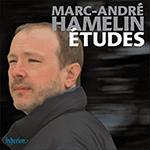
Welcome to Hyperion Records, an independent British classical label devoted to presenting high-quality recordings of music of all styles and from all periods from the twelfth century to the twenty-first.
Hyperion offers both CDs, and downloads in a number of formats. The site is also available in several languages.
Please use the dropdown buttons to set your preferred options, or use the checkbox to accept the defaults.

The result has always been one of my favourites in the set, although it hasn’t yet received as much attention from pianists as some of the others. Years ago I was fond of describing the piece as the original Chopin étude heard through about twenty feet of water. This is the crudest way to explain what goes on here, but there is a grain of truth: everything is distorted—melody, mode, harmony, timbre, texture, even the pianist’s physical feeling compared with playing the original.
from notes by Marc-André Hamelin © 2010
Le résultat a toujours été l’un de mes préférés dans ce recueil, bien qu’il n’ait pas encore autant attiré l’attention des pianistes que certaines autres études. Il y a des années, j’aimais décrire cette pièce comme l’étude originale de Chopin jouée sous environ six mètres d’eau. C’est une façon très rudimentaire d’expliquer ce qui se passe ici, mais il y a un brin de vérité: tout y est déformé—la mélodie, le mode, l’harmonie, le timbre, la texture, même le sentiment physique du pianiste comparé à ce qu’il ressent lorsqu’il joue l’original.
extrait des notes rédigées par Marc-André Hamelin © 2010
Français: Marie-Stella Pâris
Das Ergebnis war immer eines meiner Lieblingsstücke dieser Sammlung, auch wenn ihm von den Pianisten bisher noch nicht so viel Aufmerksamkeit entgegengebracht wurde wie einigen anderen. Vor Jahren charakterisierte ich das Stück gerne als die Originaletüde von Chopin, wie sie aus einer Wassertiefe von 20 Fuß klingt. Es ist die vielleicht geschmackloseste Erklärung für das, was hier geschieht, aber sie enthält ein Körnchen Wahrheit; alles ist verzerrt: Melodie, Takt, Harmonie, Klang und Struktur, sogar das physische Spielgefühl des Pianisten im Vergleich zum Original.
aus dem Begleittext von Marc-André Hamelin © 2010
Deutsch: Ludwig Madlener
 Hamelin: Études Hamelin: ÉtudesHamelin plays Hamelin: a glimpse into the fabulously bizarre musical mind of one of the greatest piano virtuosos of today. Marc-André Hamelin’s 12 Études, written over a period of nearly twenty-five years, have already achieved cult status by repu ...» More |

